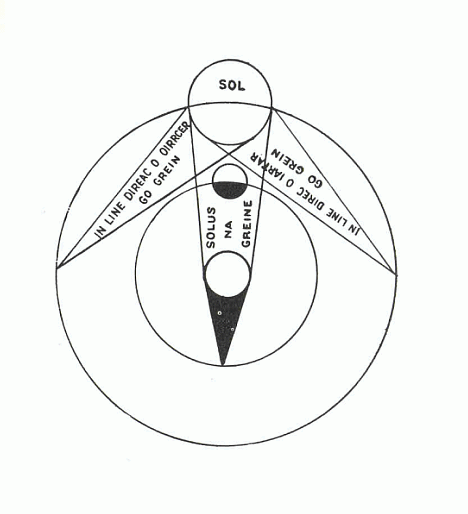
I declare that the moon is the cause of the eclipse of the sun, because its sphere is the lowest of the heavenly spheres, and the sphere of the sun is the fourth sphere above that, and, accordingly, every course it makes is beneath the sun. When it arrives at the head or the tail of the Dragon, in exactly the same degree as the sun, without inclining to the south or to the north, it deprives us of the light of the sun, and that darkness is an eclipse. When, however, it the moon inclines to its right or left side, and does not move exactly in the head or in the tail of the Dragon beneath the sun in the same degree as it, it avoids producing an eclipse. That darkness which is seen on the sun, when there is an eclipse, is the body of the moon; therefore, it is evident that an eclipse never occurs, except when the moon is exactly beneath the sun in the same degree as it. It always begins to the west side of the sun and finishes in the east. When the moon moves outside that exact degree of the sun, it sometimes obscures a portion of the sun from us. Therefore, an eclipse of the sun is of two kinds as is an eclipse of the moon, i.e., total and partial.
The eclipse varies in various lands, for when there is an eclipse it is not visible to the same extent in every land, for there is one land in which it is visible, and another in which it is not, and one land in which it is more visible, and another in which it is less visible; in this wise:—If the sun were in the straight line up over our heads and the moon in the same line beneath it, it would necessitate an eclipse for us. If a person were at the same time in the east of the world, looking at the sun, he would imagine he saw it in the west of the world, and if there was another person at the same time in the west of the world beholding the sun he would imagine he saw it in the east of the world, but neither of them see the eclipse of the sun
An eclipse of the sun is of shorter duration than an eclipse of the moon on account of the rapidity with which each passes the other, but not so is an eclipse of the moon, which is caused by the earth. There is nothing interfering with it but the course of the moon above whilst the earth is stationary.
If anyone opposed me in this by saying that the moon is not the cause of the eclipse of the sun, and that if it were as I said, it would not be more fitting for it to cause an eclipse than for Venus and Mercury when they are in the straight line beneath the sun, I answer him thus: When Venus and Mercury are beneath the sun in the same degree as it, it is as regards longitude, but then there is a decrease in them in size and width (sic).22 The same thing often happens the moon, for it is often beneath the sun in the same degree as it, as regards longitude, and yet it is far from it in latitude.
In the same way an eclipse of the sun is not caused by the stars of less magnitude than the moon, or (by stars) nearer to it, because, when a small body is placed under a large body near it, the nearer it is to it the less of it it conceals, and when it is placed far away from the large body, and near the sight which is looking at both, the further it recedes from the large body, and the nearer it approaches the sight, the more does it conceal the large body; so that in this manner a wild apple would conceal the body of the sun from the sight.
To explain this, I will make a figure here below
